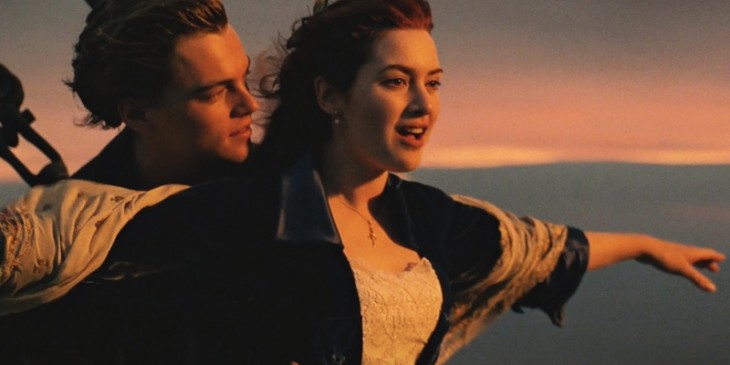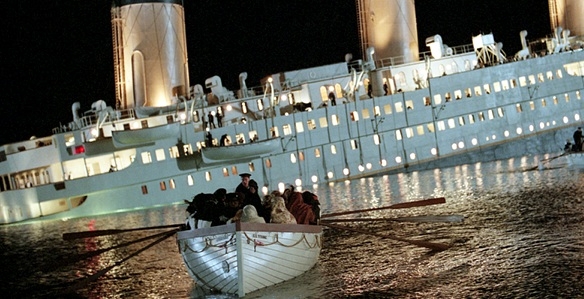Titanic 3D


To commemorate the one hundred year
anniversary of the sinking of the RMS Titanic in 1912, director James
Cameron recently rereleased his blockbuster film in 3D and now its time
for Blu-ray owners to experience the remastered edition of the Titanic.
Thanks to the dedication of James Cameron and producer Landau who
oversaw the digital remastering of the original film, both the video and
the audio have received a huge facelift which looks amazing on Blu-ray
and almost makes it appear like it was filmed yesterday. With releases
such as Indiana Jones and Jaws on Blu-ray, the Titanic 3D Blu-ray is
easily the most impressive, especially with the inclusion of 3D which
adds some great depth to the story.

The film begins in modern times when a
group of treasure hunters, including Brock Lovett (Bill Paxton), are
using technology to try and extract objects from the wreckage of the
Titanic. Luck stumbles upon them when they are contacted by an elderly
woman named Rose (Gloria Stuart) who says she is the woman in one of the
drawings they found. When they ask her about the whereabouts of a
diamond called the 'Heart of the Ocean', she recalls her time on the
ship to them. Boarding the Titanic as a young woman, Rose (Kate Winslet)
feels smothered by her family, including her dogmatic fiancé Cal (Billy
Zane) and her mother Ruth (Frances Fisher). Staying on the lower decks
is Jack (Leonardo DiCaprio), an artist who won his ticket in a poker
game. One night Jack saves Rose from throwing herself off the back of
the ship and they start to fall in love with each other. Their affair is
disrupted by Cal and his bodyguard and the collapse of the ship after it
strikes the iceberg.
How did he do it? When James Cameron's film was first released in 1997
it was regarded as one of the most lavish and expensive films of all
time. Yet despite winning a record number of awards its reputation as a
great American film has been tarnished. Titanic's most iconic moments
have been imitated and mindlessly parodied so frequently that it is easy
to forget that the film is not only a great love story but also one
deeply critical of capitalism, self-interest and ambition. Watching the
film today and it has not aged in the slightest. There are sequences so
extraordinary that they continue to defy our comprehension for what is
possible in modern cinema. Depending on your love of 3D, some have
considered this release as a superfluous 3D conversion but unlike
Cameron's Avatar (2009), this film was not shot for 3D and surprisingly
there are some decent standout moments thanks to this technology.
Even if you have watched Titanic to death,
the FULL HD release, especially in 3D warrants another viewing, not only
because it is visually spectacular but also because the film's powerful
moral core has been sustained, elevating it above the conventions of its
love story and into a timeless critique of human indecency. The film
documents how there were so few lifeboats available on the Titanic that
only half the ship's passengers could be saved because there was little
thought of aiding the lower-class decks. Watching the film again after
the GFC, where the wealthy showed equally little compassion and it is
apparent that nothing between 1912 and 2012 has changed. The way the
film damns the wealthy upper-class, harking back to the Capra-era of
filmmaking, means that Cameron could quite rightly be accused of being
hypocritical. He is a director deeply embedded in the Hollywood system
and has made two of the highest grossing films of all time, one of which
is Titanic itself. Yet when people rewatch this film they will be
reminded of just how much anger and guilt Cameron shares between himself
and the screen.
Consider for example the way that Cameron has chosen to frame the
narrative to project his own self-refection. Brock and his team are
treasure hunters, who initially seem only interested in the valuables
and the technology, exploiting the ruins of the vessel. When he
demonstrates the dismantling of the ship on the computer one of the men
says to Rose: "Pretty cool huh?" Yet by the end of the film Brock and
his crew are unexpectedly moved by Rose's story because they have a
greater sense firsthand of what a terrible experience this was for her.
Assumedly, this is a mirror of Cameron's own experiences in researching
and creating this film, appreciating it as far more than just a
commodity. Overcoming blind idealism is therefore one of the film's
central themes and is visualised spectacularly through Cameron's
sophisticated formalism. Before stepping onto the ship, the low angle
shots looking up at the Titanic heighten its grandeur. This is to show
how people foolishly believed that it was indestructible because of its
size and its power.

The fluency of the camera as it sweeps across the decks is also
significant because it leads one into a false sense of liberty,
believing that there is great freedom and spatiality to be found
onboard. This is contrasted with the interior rooms, where cabins,
dining rooms and corridors are tightly framed and shot. The delicacy and
elegance of the camera movement on the upper decks is used to show how
controlled and suppressed Rose's life is as a woman. Her mother even
mentions that she doesn't need to go to university because she is
already engaged. There is also a clever moment where slow motion is
briefly employed to further show the contained, mechanical nature of her
upper-class lifestyle. Smartly, Cameron's best films have subverted the
female role, where women exude more masculine qualities over the course
of the narrative. It's visible in Aliens (1986), the Terminator films
and here too. As Rose defies her family's orders the formal elements
change, like in a scene where she is dancing on the lower decks with
Jack. The rapid panning of the camera asserts her freedom and her
independence, which she will later use for her own survival.
As pure entertainment, the first two hours of the film are close to
perfection. My favourite moments are shared between the scenes at
dinner, the exterior shots and those extraordinary early moments where
Cameron films the actual wreckage of the Titanic. Fulfilling many of
these classic scenes are touches of wit and humour and two charismatic,
star-making performances from DiCaprio and Winslet, both of whom have
gone on to have distinguished careers. It is surprising that Billy Zane
never had bigger opportunities because he makes his character so
deliciously wicked. Cal is a man who lives solely through money.
Everything can be bought for him, except love. The other side characters
are well cast with actors who give their small roles noticeable weight
too. The most poignant is the ship's architect Thomas Andrews (Victor
Garber). There's a chilling scene where he is reduced to a zombie,
watching a clock as his dream collapses around him, weighed down by
helplessness and guilt for designing the ship. Frances Fisher as Rose's
mother is also fascinating because although her character postures as
being wealthy, and excludes others for not being in the same league, she
is aware of own family's struggling financial situation and is
determined to force her daughter to marry into wealth to save herself.
Although Cameron retains a masterful grip on the action, the film
falters marginally as the ship begins to collapse. The scenes of Rose
running down long white corridors are so isolating they could be
straight from a horror movie. But these sequences could have been leaner
and there are contrivances that see the narrative veer unnecessarily
close to melodrama. Did Rose really need to jump back onboard the ship?
The film recovers strongly because the final moments alone in the cold
black water are deeply moving. With nothing to save these people, the
sense of loss and despair is palpable and haunting. The film favours
moral complexity over simplistic emotions of physical suffering too.
Cameron unflinchingly shows us the cowardice, the arrogance and
self-interest of people who opt only to save themselves, while the
others are left to freeze to death in the icy water. On Blu-ray, the
video and audio quality is exceptional that really draws you into the
memorable story that is not only visually stunning, it is compulsive
viewing because of its intelligence and willingness to explore class,
ambition and gender politics. Best of all, Fox have released a plethora
of special features for lovers of true modern cinemas that include how
the film was made, commentaries, deleted scenes and some amazing photos.
It is not often that a film can touch a person to the core and leave an
everlasting emotional mark but Titanic is one of those films.
Special Features
-
Reflections on Titanic: A fascinating in-depth exploration of the film.
-
Titanic: The Final Word with James Cameron - Produced by National
Geographic, this piece brings the world’s leading Titanic experts
together to solve the lingering mysteries of why and how the
'unsinkable' ship went down.
-
29 deleted Scenes
-
Alternate Ending
-
More than 60 Behind-The-Scenes Featurettes
-
A Look At The Groundbreaking Visual Effects
-
More than 1,000 photos
-
3 Commentaries
-
And Much More!